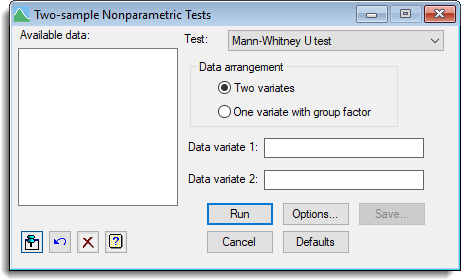Select menu: Stats | Statistical Tests | Two-sample nonparametric tests
Performs nonparametric statistical tests on data comprising two samples.
- After you have imported your data, from the menu select
Stats | Statistical Tests | Two-sample nonparametric tests. - Fill in the fields as required then click Run.
You can set additional Options, then after running you can save the results by clicking Save.

Test
Specifies the test to be carried out:
| Wilcoxon Matched-Pairs test | This is a nonparametric test of location for two related samples (for example a before-and-after study). The null hypothesis is that the samples arise from exactly the same distribution, and this is tested against the alternative that the underlying distributions differ in their locations |
| Kolmogorov-Smirnov test | This is a test of the hypothesis that two samples of data have arisen from the same distribution, against the alternative, that the underlying distributions are different. The test statistic is the maximum absolute difference between their cumulative distribution functions |
| Spearman’s rank correlation | Spearman’s rank correlation coefficient is a measure of the association between the rankings of two samples and can be used to test for independence of the samples |
| Mann-Whitney U test | This is a test for differences in location between two samples of data |
| Sign test | The two-sample sign test is a nonparametric test for difference in location between two related samples |
Available data
List variates and factors that can be used to supply the data sets and groups. The contents will change as you move from one input field to another, so that appropriate types of data structure are listed. Double-click a name to copy it to the current input field or type the name.
Data arrangement
You can supply the data either as a pair of variates or as a single variate with a factor defining the groups. Note: for the Wilcoxon test you can only supply data as a pair of variates of equal length.
| Two variates | You must supply the samples as two separate variates. Enter the names as Data variate 1 and Data variate 2. |
| One variate with group factor | You must supply the data in one variate, specified as the Data variate. Membership of the two samples is then indicated by a factor by entering the name in Group factor. |
Action Icons
| Pin | Controls whether to keep the dialog open when you click Run. When the pin is down |
|
| Restore | Restore names into edit fields and default settings. | |
| Clear | Clear all fields and list boxes. | |
| Help | Open the Help topic for this dialog. |
See also
These statistical tests are performed by the following procedures which may also be used in command mode with additional parameters in some cases: WILCOXON, MANNWHITNEY, KOLMOGOROV, SIGNTEST, SPEARMAN
The descriptions of these commands contain full details of the methods used to calculate the test statistics, along with suitable references.